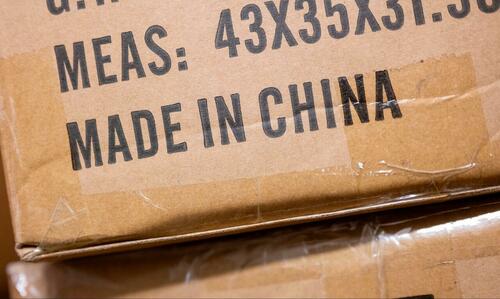Authored by Spencer Morrison via American Greatness,
The free trade brigade obsesses over economic minutiae – they cry that tariffs will raise the cost of plastic spatulas by 50 cents!
What a disaster!
Who cares?
The reality is that trade with China is not in America’s interests because it funds our greatest rival.
Here’s how America funded China’s rise, and why tariffs will help keep America safe and free.
A Dragon Fed: How America Funded China’s Rise
Economists say freer trade benefits everyone—even trade with China. America gets cheap goods and China gets money. Win-win.
Even if we assume America benefits, which is a false assumption as proven in my book Reshore, China has clearly benefited more. For example, China’s economy has grown by an average of 8.12% since joining the World Trade Organization in 2001—about four times greater than America’s. China and America benefited asymmetrically from trade.
Asymmetry may not be a problem economically, but it is a problem politically. Why? Power is zero-sum. The stronger China grows, the weaker America becomes relative to China. As such, trade with China is also a political issue. The question we should be asking ourselves is whether cheap goods are worth surrendering America’s political dominance.
To be clear, trade is not the only way that America has funded China’s rise. There are three primary ways that America enriches and empowers China: investment, trade, and theft.
First, America invested directly in China by building factories—offshoring 60,000 factories does not come cheap. The total value of American investment in China is unknown. According to China’s Ministry of Commerce, cumulative foreign direct investment (“FDI”) totalled $2.7 trillion in 2023. Just 2.1% of this investment was categorized as American.
The reason that this amount is so low is because American investment is usually routed through intermediaries, mostly Hong Kong, Singapore, and the British Virgin Islands. This is why Hong Kong—a city smaller than Shanghai—owns 68% of FDI in China.
Not coincidentally, Hong Kong is a major recipient of FDI from the U.S. and from the British Virgin Islands—a tiny banking archipelago that is itself capitalized by the U.S. and the City of London. Because of this shell game, we cannot know the actual amount American companies have invested in China, but if we assume that FDI correlates with the relative size of China’s trade surpluses, then America’s investments total $972 billion.
This estimate is probably low. Why? China runs trade surpluses with countries that clearly contributed no investment, such as most countries in Africa and the Middle East. Given the level of economic integration, I would hazard an estimate that most FDI ultimately originated in America or the City of London, funneled through their banking havens.
Second, America indirectly funded China’s rise through the trade deficit, buying more Chinese goods than we sold. The cumulative trade deficit with China since 2001 is roughly $6 trillion, after accounting for inflation.
Not only were the Chinese able to spend these profits, but they were also able to borrow against the revenue, greatly multiplying their access to capital.
Third, China has stolen an almost unquantifiable amount of American technology. In 2017, the Office of the United States Trade Representative estimated that China steals intellectual property worth between $225 and $600 billion per year, more than the value of the annual trade deficit. If we use the low estimate and do not adjust for inflation, the value of stolen technology would be at least $5.4 trillion.
Interestingly, the above numbers actually undervalue the quantity of this theft. Why?
Because most of the technological and IP outflows are not stolen in a traditional sense. For example, the main vector of technological transfer is via Chinese companies using their profits from the trade deficit to buy shares in American companies, at which point they own the technology. Currently, foreigners own 17% of American equities, and the number is growing.
The other vector is through Sino-American corporate partnerships. Basically, American companies that build factories in China are forced to partner with a local Chinese company, a corporate clone. The plant is staffed by Chinese workers, who are taught America’s industrial processes and how to replicate American technology.
Providing China access to American technology is actually the price to enter China’s market—American companies cannot operate in China without giving up their technological and industrial secrets. Yet they do it anyways because the Chinese make it worth their while.
In my view, the value of America’s stolen technology was priceless.
Remember, mainland China’s economy was largely preindustrial—about as productive and technologically advanced as the Thirteen Colonies during the American Revolution. Now, China has reached technological parity with the U.S. Theft allowed China to skip 200 years of technological and economic development.
America funded China’s rise. This has not only impoverished America, but it has also ended America’s superpower era. We now live in a multipolar world, bought and paid for by America’s corrupt politicians and Wall Street.
Views expressed in this article are opinions of the author and do not necessarily reflect the views of ZeroHedge.
Loading…


















